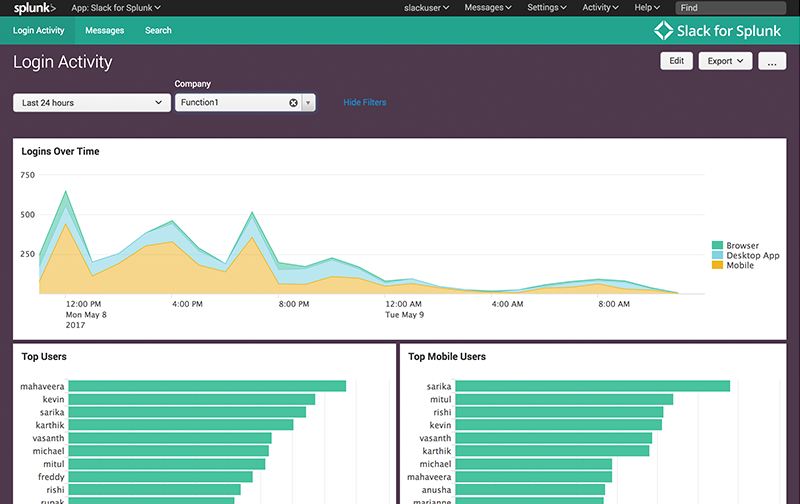Log management solutions play a crucial role in an enterprise's layered security framework— without them, firms have little visibility into the actions and events occuring inside their infrastructures that could either lead to data breaches or signify a security compromise in progress. Splunk and ELK (a.k.a BELK or Elastic Stack) are two of the leading enterprise solutions in this category; let's see how they stack up in this comparison.
Most, if not all, systems and devices in today's IT environments generate extensive logfiles that record the minutiae of day-to-day operations: what resources were accessed and by who, activities performed, errors/exceptions encountered by the host, and more. As you can imagine, the volume of logfiles in any given organization's infrastructure can quickly become unwieldy. Log management and analysis solutions enable organizations to glean collective, actionable intelligence from this sea of data.
I am looking to create a Splunk alert that posts to the Slack channel and mentions a particular user group so a badge appears next to the channel for all members of that particular group. For example: If the alert says 'host is down', I want the user group @prodSA to be mentioned in the alert so the. Slack, which was founded in 2010 by Mr. Butterfield, grew quickly and previously attracted — and rejected — takeover offers from the likes of Google, Microsoft and Amazon. Its valuation was.
Splunk
Known as the 'Google for logfiles,' Splunk is also marketed as a Security Information and Event Management (SIEM) solution, on top of being a log management and analysis platform. SIEM is essentially log management as applied to security: by unifying logfile data gathered from a myriad of systems and devices across an IT environment, operators and infosec professionals can perform higher-order security analyses and assessments regarding the collective state of their systems from a single interface. An abundance of SIEM products exist on the market, but Splunk reigns supreme in this category due to its aforementioned Google-esque search capabilities. The platform uses a proprietary search language called Search Processing Language (SPL) for traversing and executing contextual queries large data sets.
Splunk also features over 1000 apps and add-ons for extending the platform's capabilities to accommodate various data sources.
ELK/Elastic Stack
Short for Elasticsearch, Logstash, and Kibana, ELK is a consolidated data analytics platform from open source software developer Elastic. The company is most widely known for Elasticsearch, its scalable search platform based on Apache Lucene. As with many open source offerings targeting the enterprise, paid-for commercial support and consulting are its bread and butter. ELK's software stack consists Elasticsearch (distributed RESTful search/analytics engine), Logstash (data processing pipeline), and Kibana (data visualization). More recently, Beats made its way into the stack, offering agent-based single purpose data shipping. This conglomerate is now marketed by Elastic as the open source Elastic Stack.
In addition to the ELK/Elastic stack, each of these technologies is available as a discreet offering from Elastic.
Side-by-Side Scoring: Splunk vs. ELK/Elastic Stack
1. Capability Set
Splunk and ELK/Elastic Stack are powerful, comprehensive log management and analysis platforms that excel in fulfilling the requirements the most demanding enterprise use cases. Both are highly customizable and offers a range of features you'd expect from a competent solution in this category: advanced reporting, robust search capabilities, alerting/notifications, data visualizations, and more.
2. Ease of Use


Both solutions are relatively easy to deploy and use, especially considering each respective platform's breadth of features and capabilities. That said, Splunk's dashboards offer more accessible features and its configuration options are a bit more refined and intuitive than ELK/Elastic Stack's. Additionally, ELK's user management features are more challenging to use than Splunk's. On the other hand, AWS offers Elasticsearch as a service that removes much of the difficulty in deploying and managing it.
| Splunk | ELK/Elastic Search |
| 4/5 | 4/5 |
3. Community Support
Both are market leaders in their respective categories with a large community of users and supporters. Open source has its advantages, however, and ELK/Elastic Stack boasts a highly active and responsive developer/user community, as well as an abundance of resources available online. Check out Elastic's library of community-contributed clients for various programming languages.
4. Release Rate
Both solutions have seen regular releases over the years: Splunk's enterprise offering is currently at version 6.5, while ELK/Elastic Stack releases—as a composite platform—are stratified per component. Currently, Elastic Stack (as well as its core components: Kibana, Elasticsearch, Beats, and Logstash) is at version 5.0. Full release histories for Elastic and Splunk are available on the vendors' websites.
| Splunk | ELK/Elastic Search |
| 5/5 | 5/5 |
5. Pricing and Support
Splunk is a proprietary enterprise offering with a high end price tag while ELK/Elastic Stack is a free, open source platform. Despite this, ELK/Elastic Stack's cost total cost of ownership can be quite substantial as well for expansive infrastructures: hardware costs, price of storage, and professional services can quickly add up (though the aforementioned AWS service can simplify that if cloud-hosting is a viable option). Both Splunk and ELK/Elastic Stack now offer cloud-based, hosted versions for more price-conscious organizations. In terms of support, both ELK/Elastic Stack and Splunk's support offerings are exceptional.
6. API and Extensibility
Splunk offers a well-documented RESTful API with over 200 endpoints for accessing every feature in the product as well as SDKs for popular languages. ELK/Elastic Stack's Elasticsearch was designed from the ground-up as a distributed search and analytics engine using standard RESTful APIs and JSON. It also offers pre-built clients for building custom apps in languages such as Java, Python, .NET, and more.
| Splunk | ELK/Elastic Search |
| 5/5 | 5/5 |

7. 3rd Party Integrations
Splunk features over 1000 add-ons and apps in its Splunkbase app portal organized into 6 categories: DevOps, IT operations, security/fraud/compliance, business analytics, IoT/industrial data, and utilities. Not to be outdone, ELK/Elastic Stack also offers a plethora of plugins and integrations, both from the community and supplied by third-party vendors.
8. Companies that Use It
Splunk boasts over 12,000 customers and 80 of the Fortune 100 under its belt: Adobe, BlackRock, Coca-Cola, ING, Tesco, AAA, Staples, among others. Elastic's customer list is equally impressive, consisting of Ebay, Verizon, Netflix, Cisco, Salesforce, FICO, Facebook Thomson Reuters, to name a few.
| Splunk | ELK/Elastic Search |
| 5/5 | 5/5 |
9. Learning Curve
ELK/Elastic Search's learning curve is surprisingly flat for what it does; Splunk has a moderate learning curve, especially when it comes to building expertise for carrying out more specialized analyses.
10. Security rating
Splunk has a respectable security rating of 836/950 while scores a lower but still decent 779/950.
Scoreboard and Summary
| Splunk | ELK/Elastic Stack | |
| Capability set | 5/5 | 5/5 |
| Ease of use | 4/5 | 4/5 |
| Community support | 4/5 | 5/5 |
| Release rate | 5/5 | 5/5 |
| Pricing and support | 4/5 | 4/5 |
| API and extensibility | 5/5 | 5/5 |
| 3rd party integrations | 5/5 | 4/5 |
| Companies that use it | 5/5 | 5/5 |
| Learning curve | 3/5 | 4/5 |
| Security rating | 836 | 779 |
| Total | 4.5/5 | 4.5/5 |
In short, both Splunk and ELK/Elastic Stack are competent, enterprise-grade log management and analysis platforms trusted by the world's leading organizations. Total cost of ownership can be significant for both solutions; in response to demand from more budget-minded firms, Splunk and Elastic have recently started to offer hosted versions of their products.
Log analytics and SIEM only account for one piece of the continuous security puzzle. For achieving enterprise resilience, UpGuard's gives organizations the ability to validate that all IT assets in their environments are configured optimally and free from vulnerabilities– for example, that Splunk agents are installed correctly on all the servers supposed to be under management. Our platform integrates with Splunk out-of-the-box to correlate detected configuration item changes with events, resulting in more accurate insights and timely response/remediation.
Splunk Slack Integration
From Splunk Wiki
What is Slack?
Slack is a collaboration tool which is a little like IRC, but is easier for most people to use, especially in a work setting.
What is the Splunk Community Slack Team?
The Splunk Community Slack Team is a place where you can chat with other Splunk users, get help, and help others.
If you would like to join us, you can request access, fill out the form here.
How do I use this?
Splunk Slack Add On
Once you have gotten an email telling you you have been granted access, you can sign in. Information on signing into Slack can be found in the Slack Help Center.
Once you have joined, you will automatically be added to two channels, #announcements and #_where_do_I_ask.
'announcements' is a channel for space admins to make announcements for everyone. You will not be able to post to this channel, but if you have an announcement you would like to make, ask in the #slack-help channel. Folks in welcome can help route you to the most appropriate channel for your question. Here are some channels you might want to start with:
And of course, for idle chit chat, and funny pictures, there is #random.
Community Guidelines
Please read this: docs.splunk.com/Documentation/Community/1.0/community/CommunityGuidelines
A note on 'n00bs' and asking for help
Newbies are especially welcome in this group. People new to Splunk are what keeps this community healthy and growing. Everyone is new to something at some point. This community is here to help everyone. We do not tolerate the dismissal of someone as a 'n00b' or treating someone as inferior because they ask something you feel is basic.


That said, members of this Slack team are volunteers, and the majority are not paid by Splunk. Please consult available resources like Splunk docs (docs.splunk.com and dev.splunk.com) and Splunk Answers (answers.splunk.com) when looking for answers to your questions.If you’re not sure where to look, we’re happy to help!
If you are having trouble finding a Docs page (there are a lot of them) and would like help, you are welcome to ask.
Useful Slackbot commands
We've added some useful responses for Slackbot.
If you say '!channels', Slackbot will provide a list of useful channels.
If you say '!spec filename' Slackbot will provide a link to the docs page for that configuration file. For example, if you want a link to the props.conf spec documentation, you can say '!spec props'
